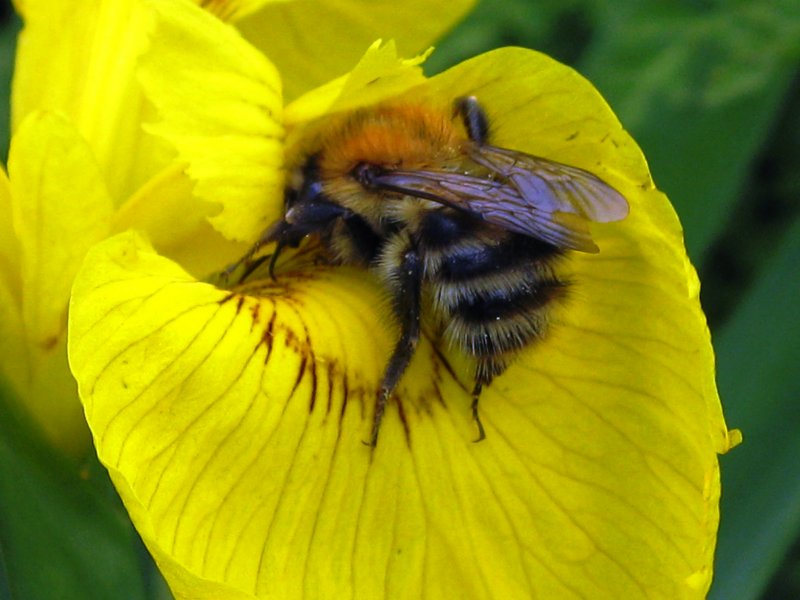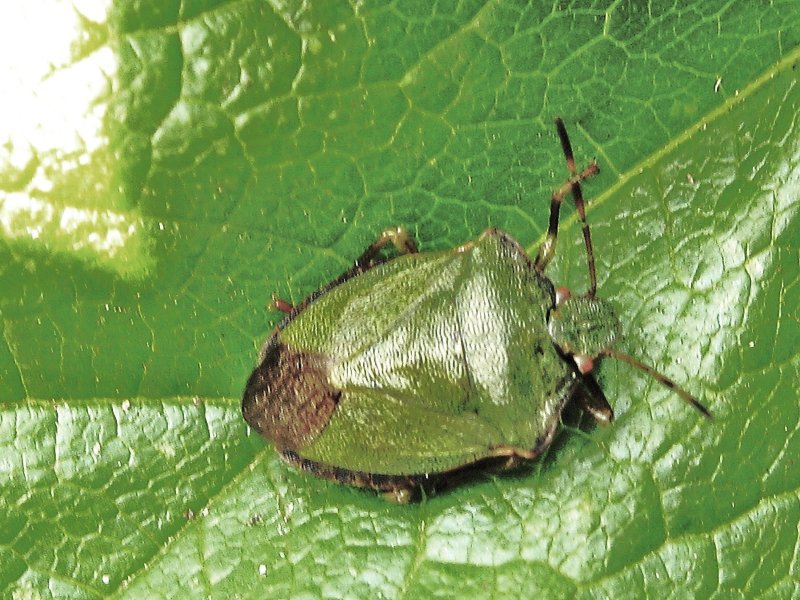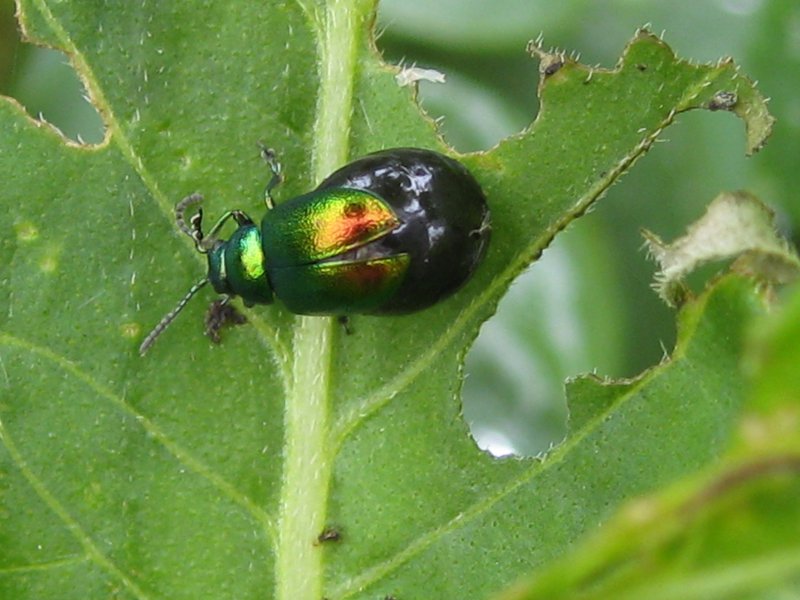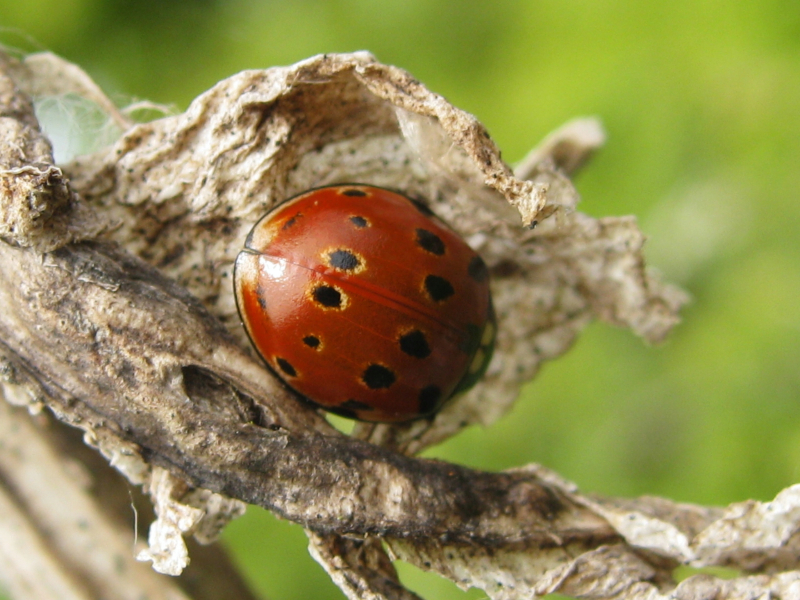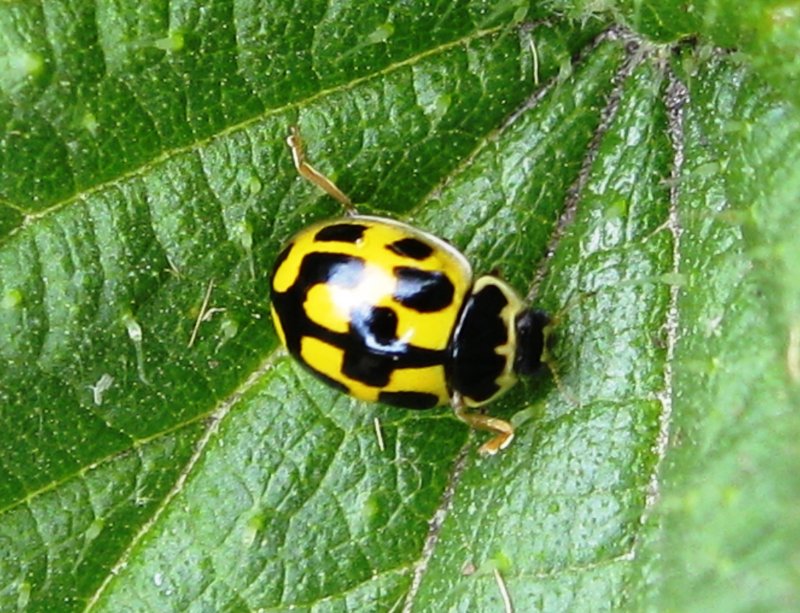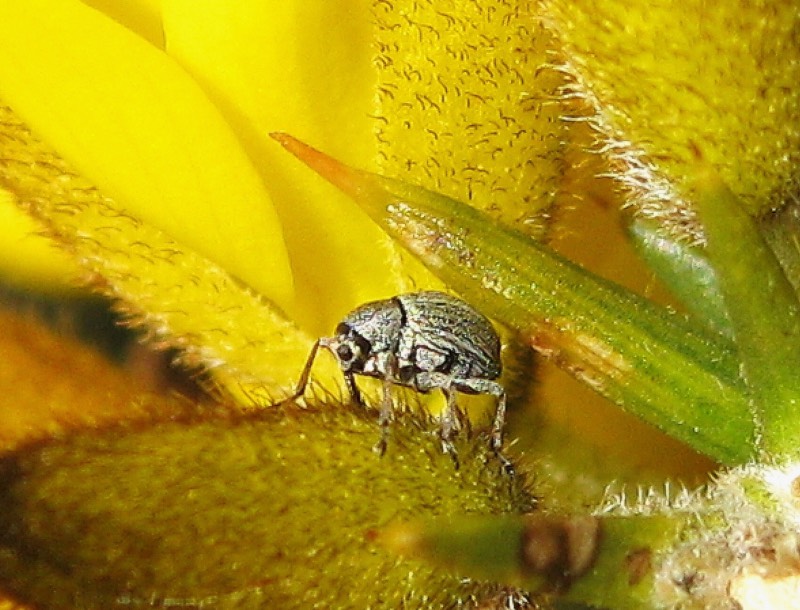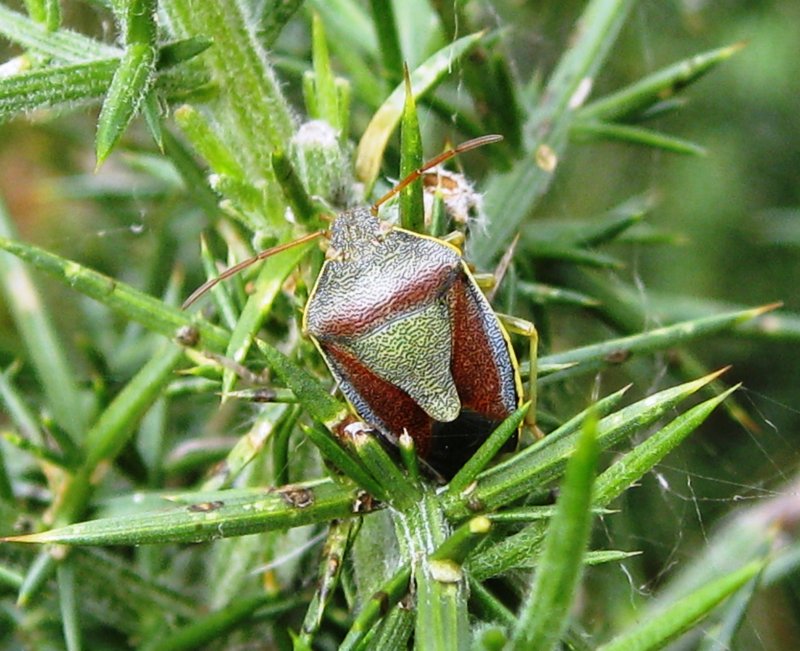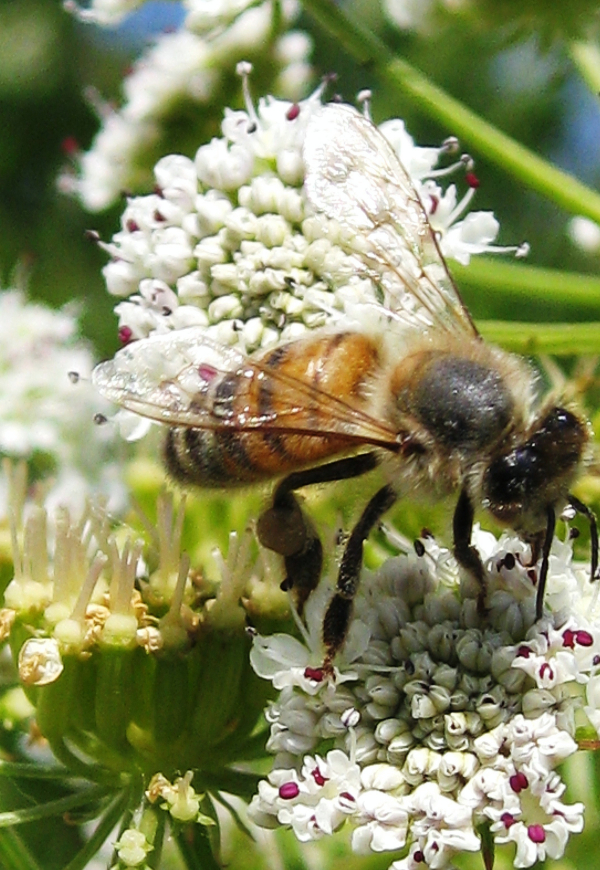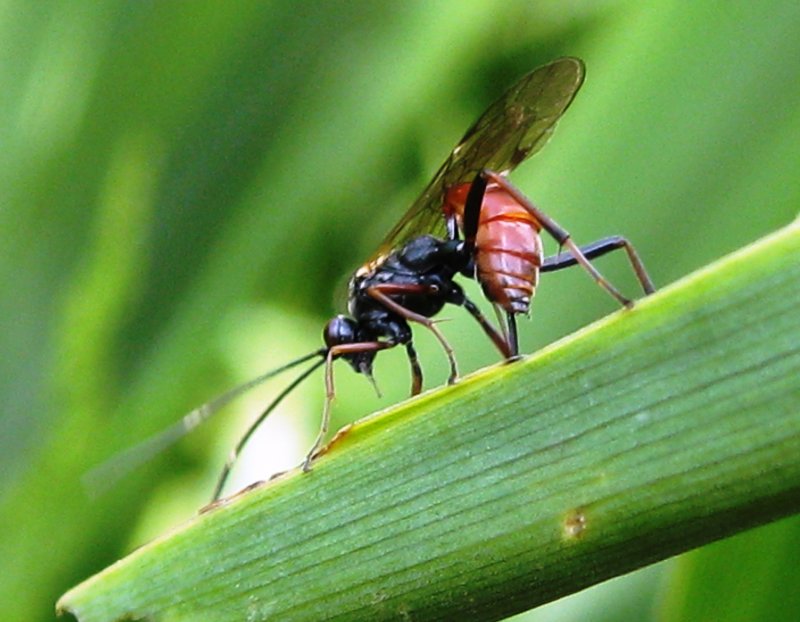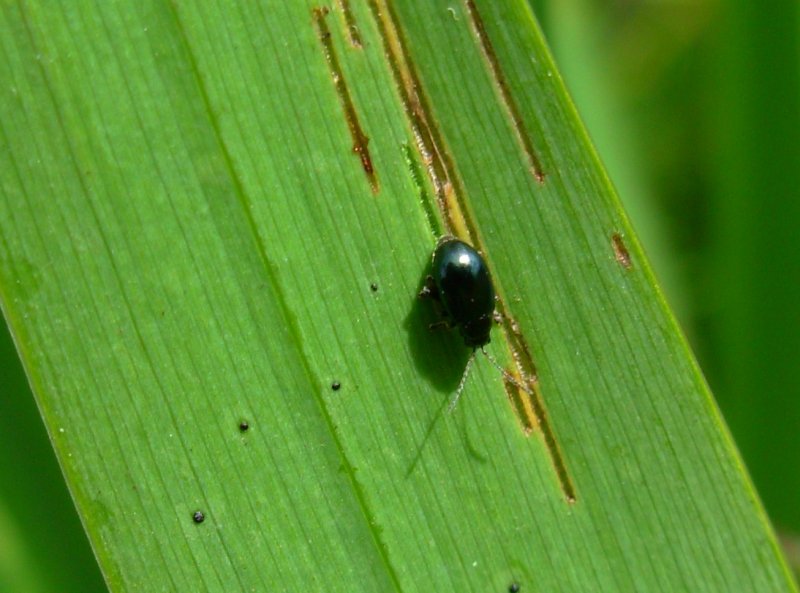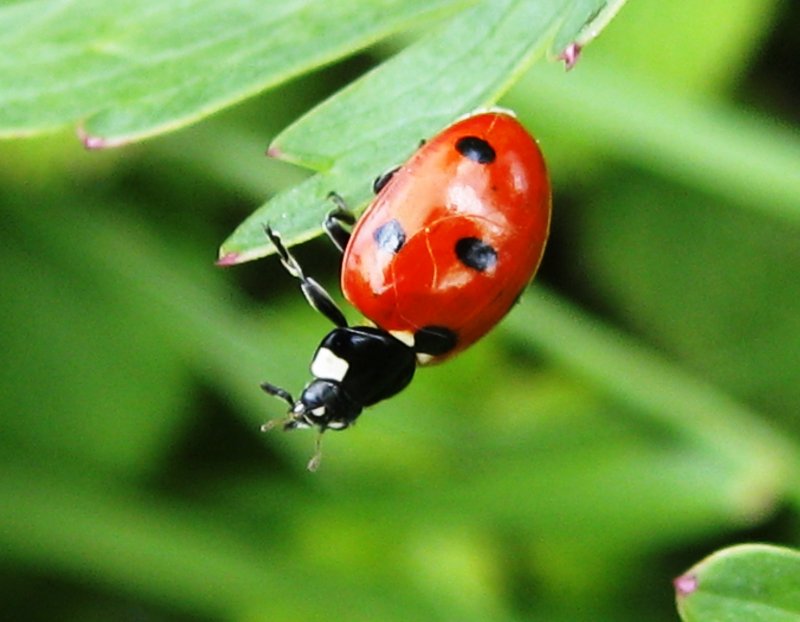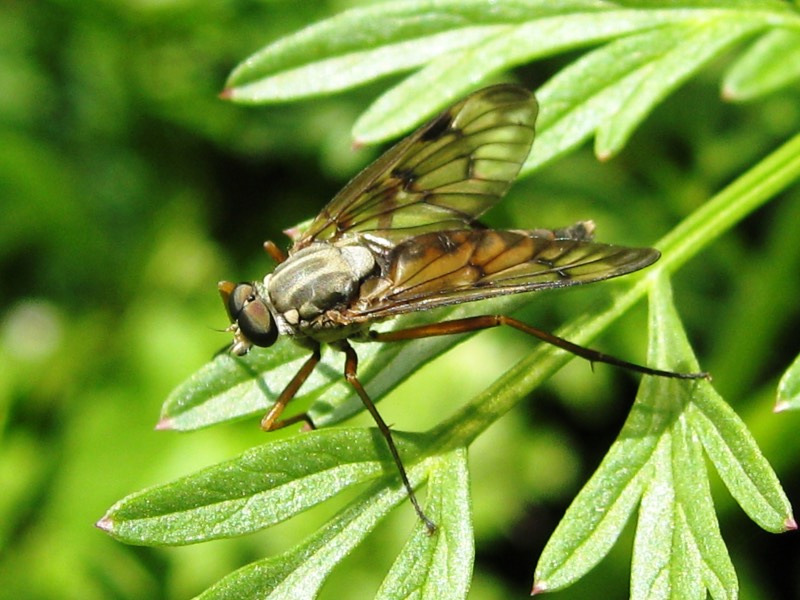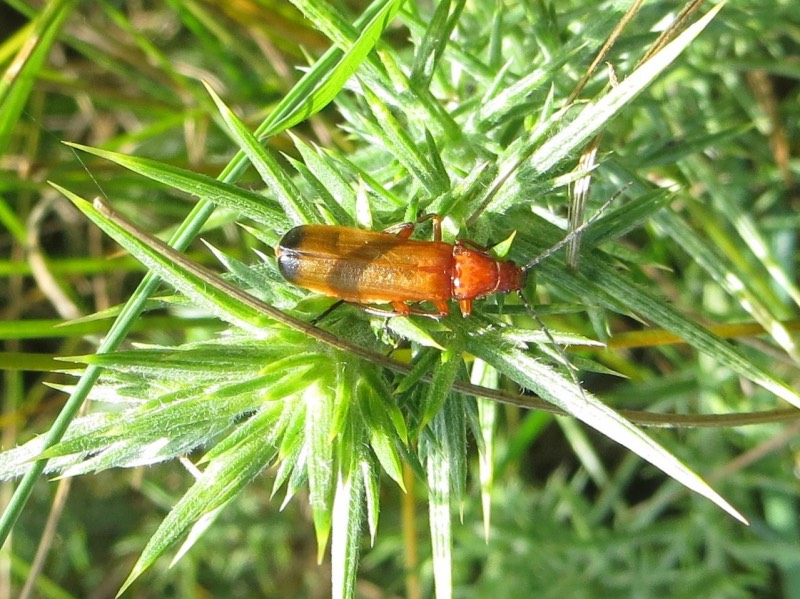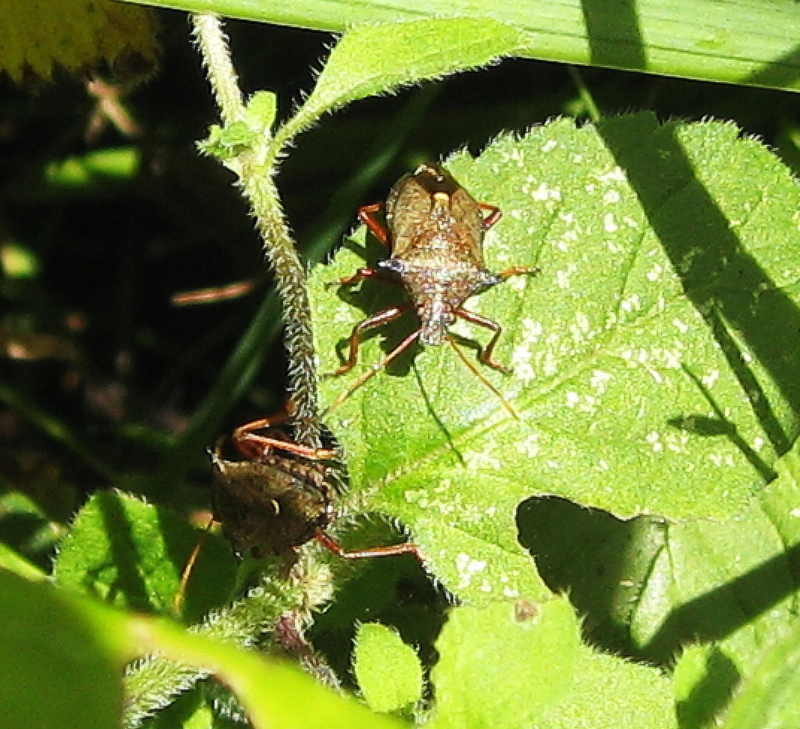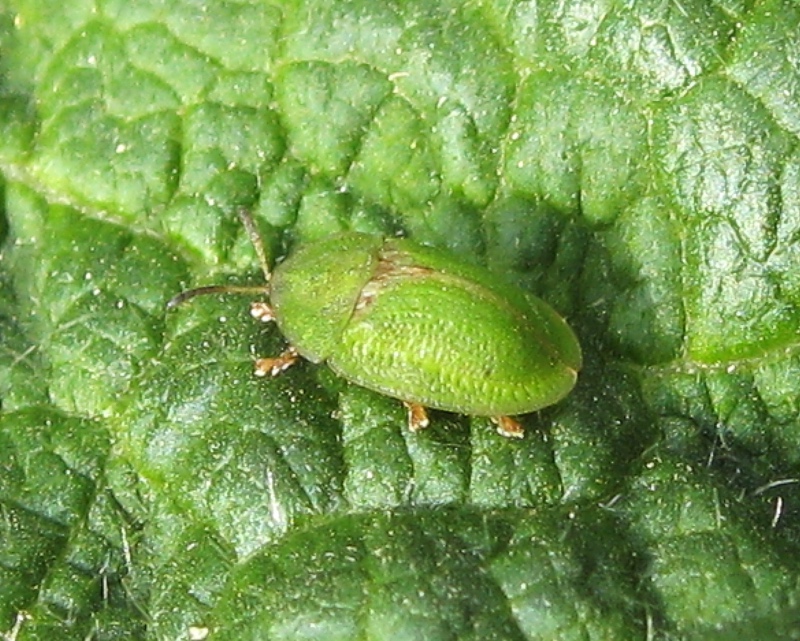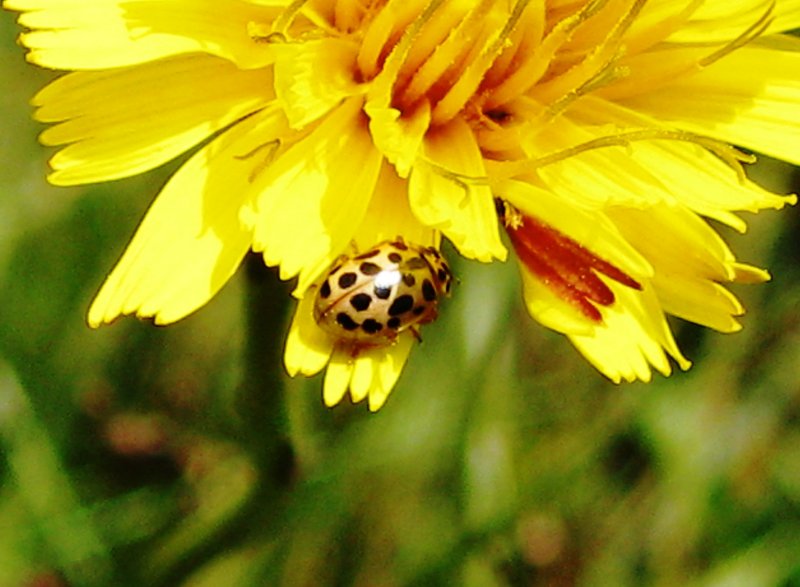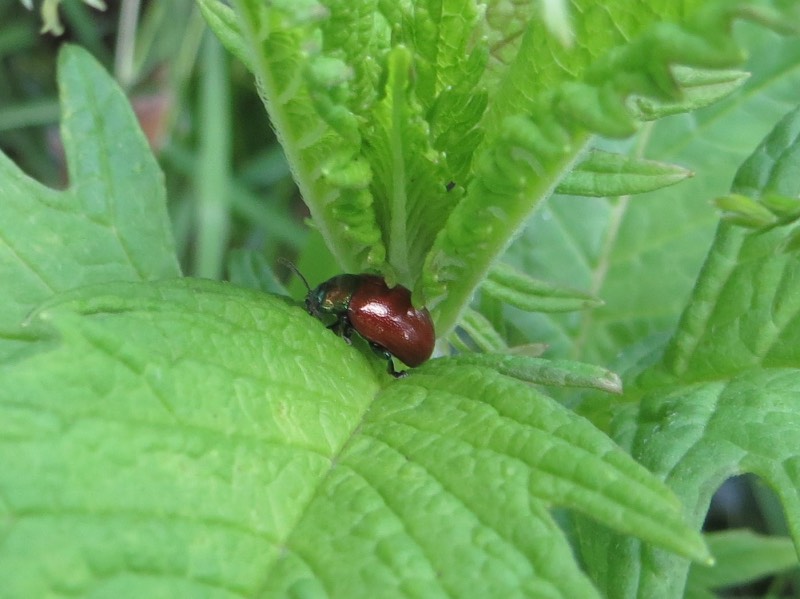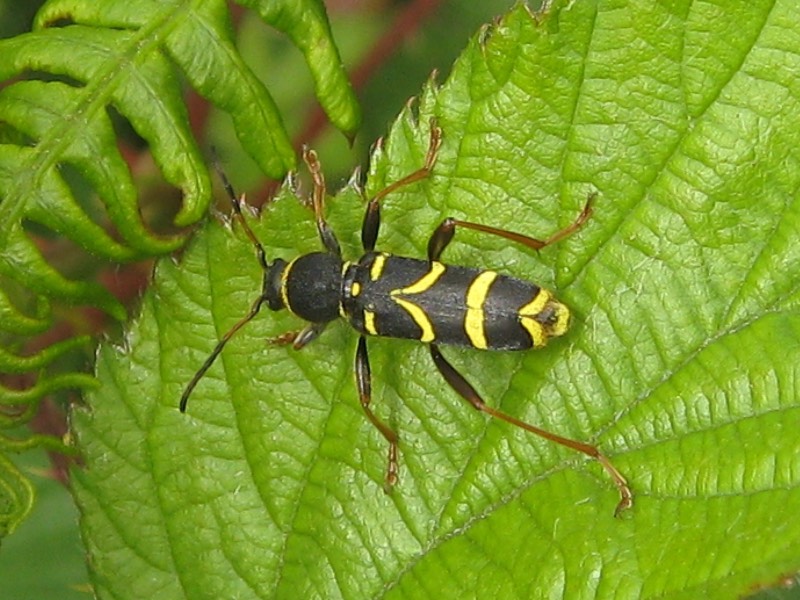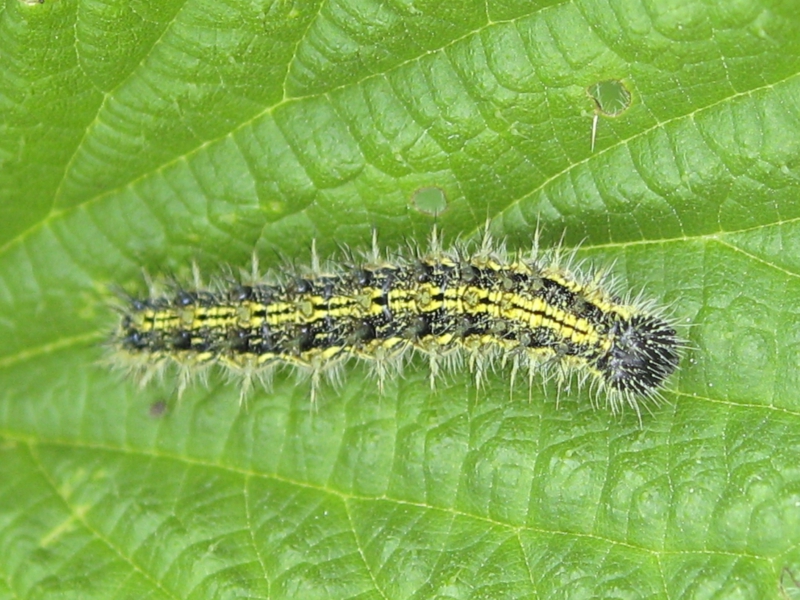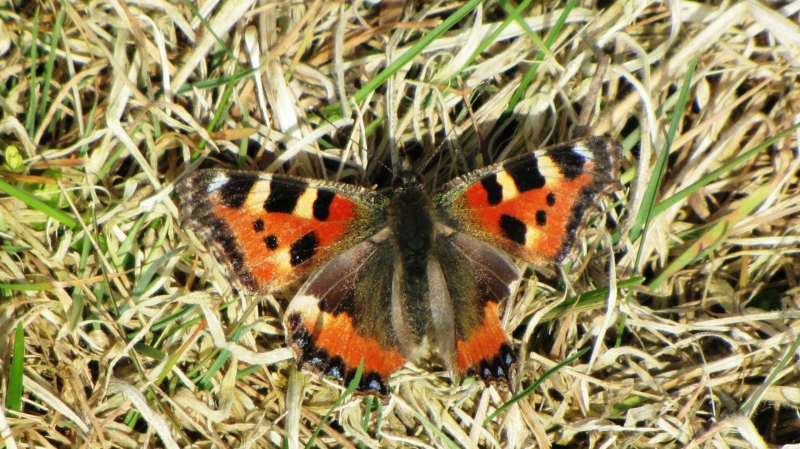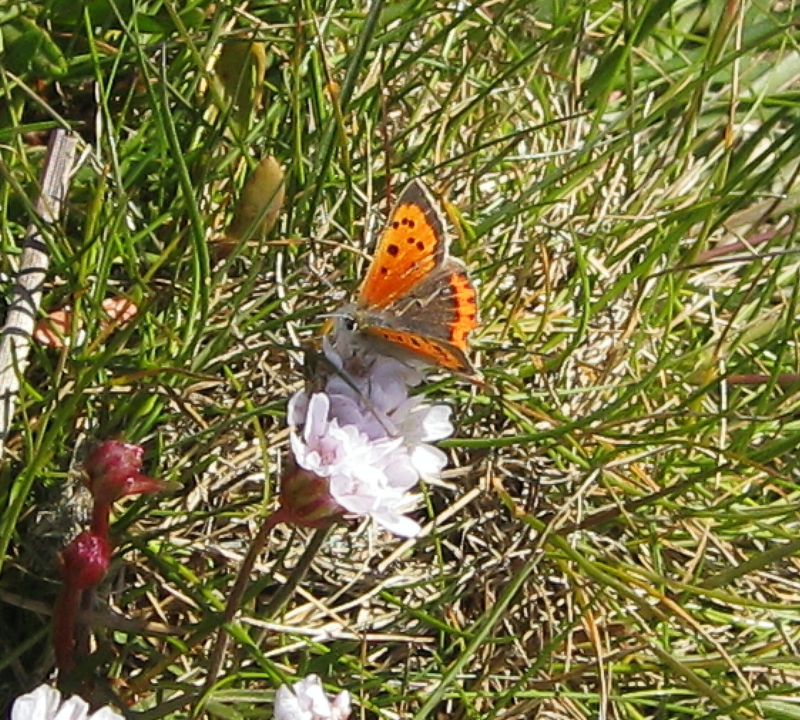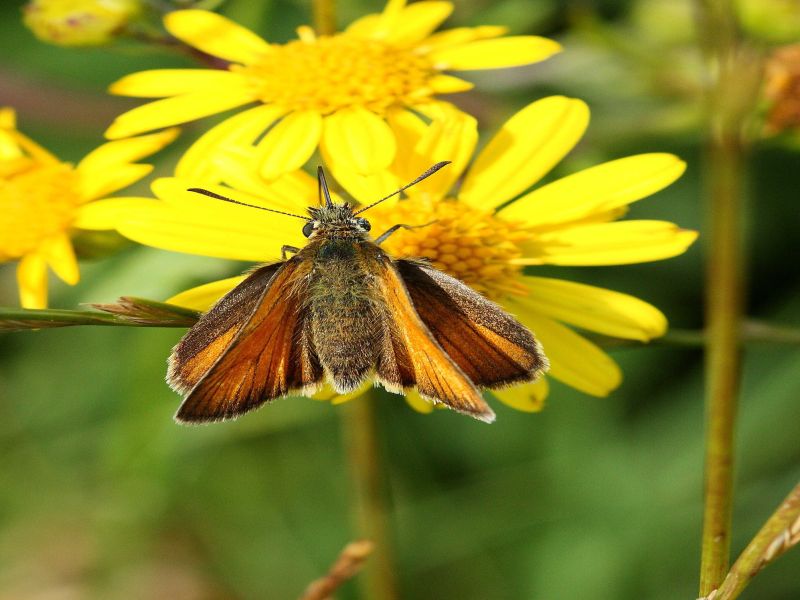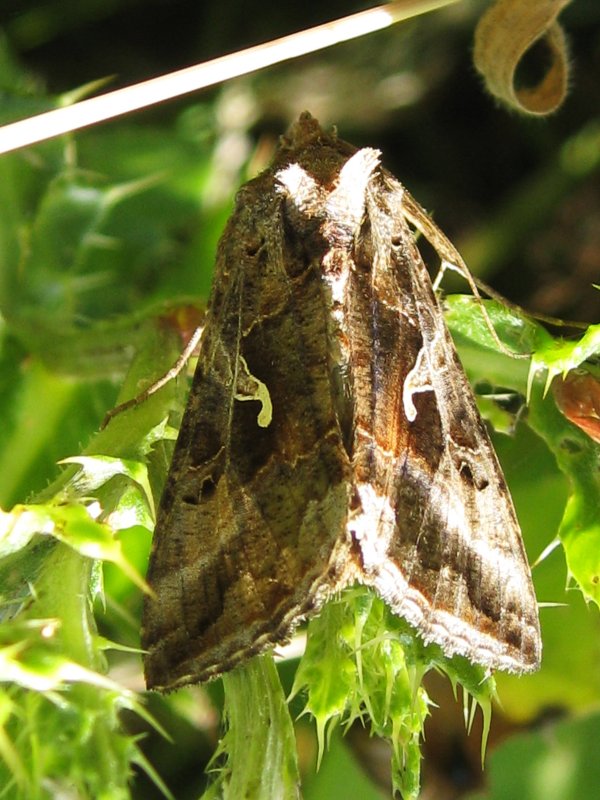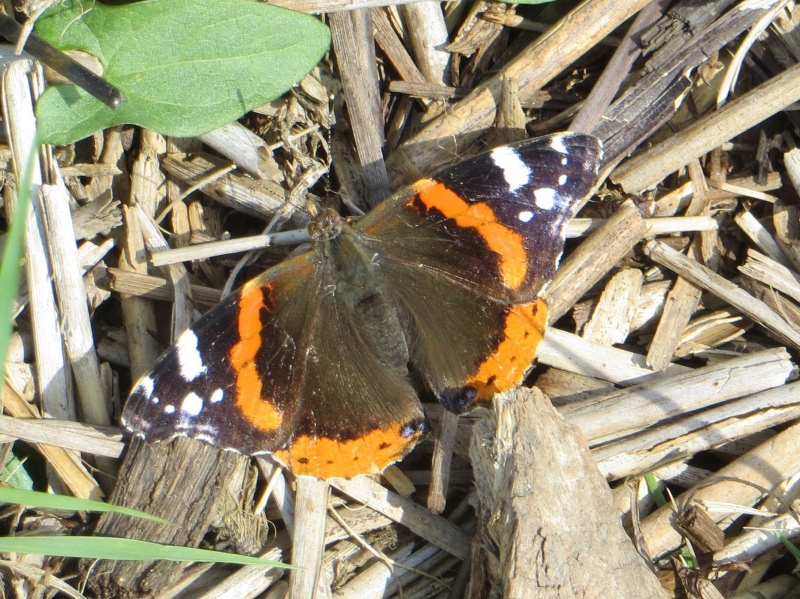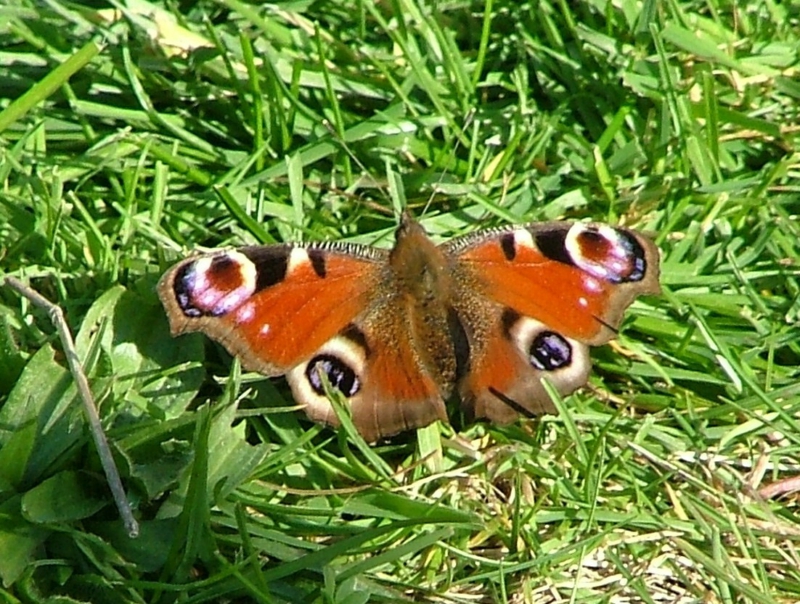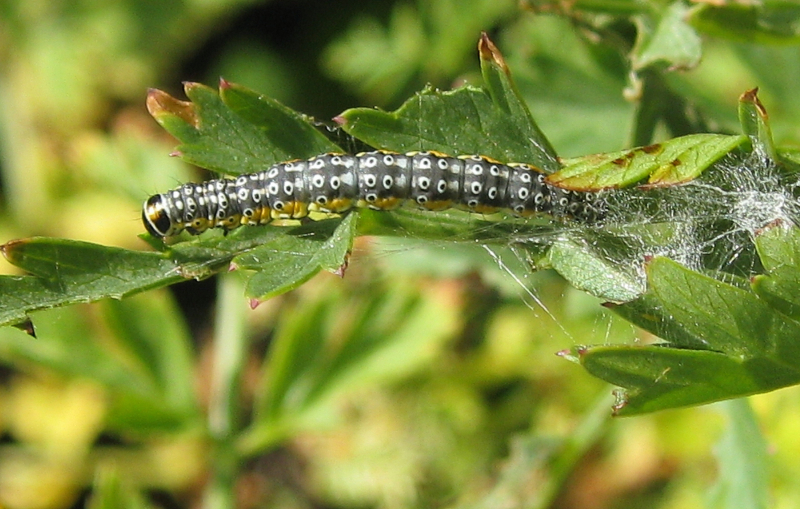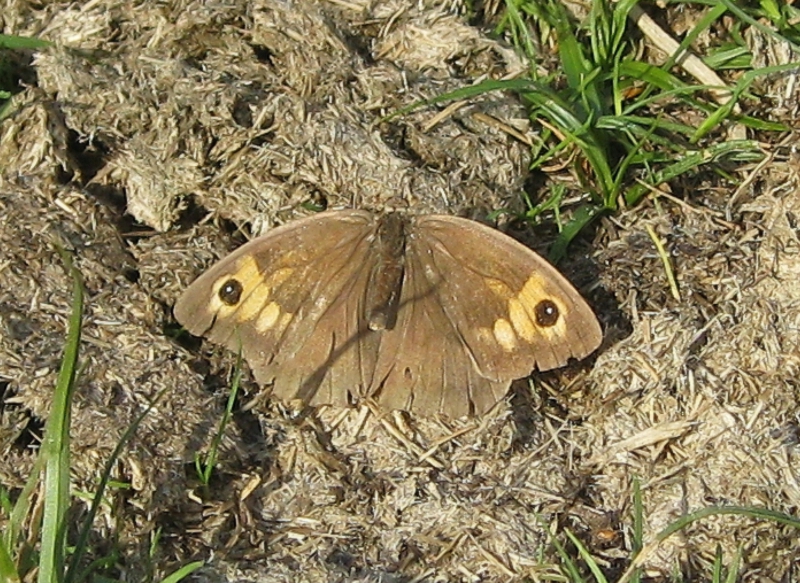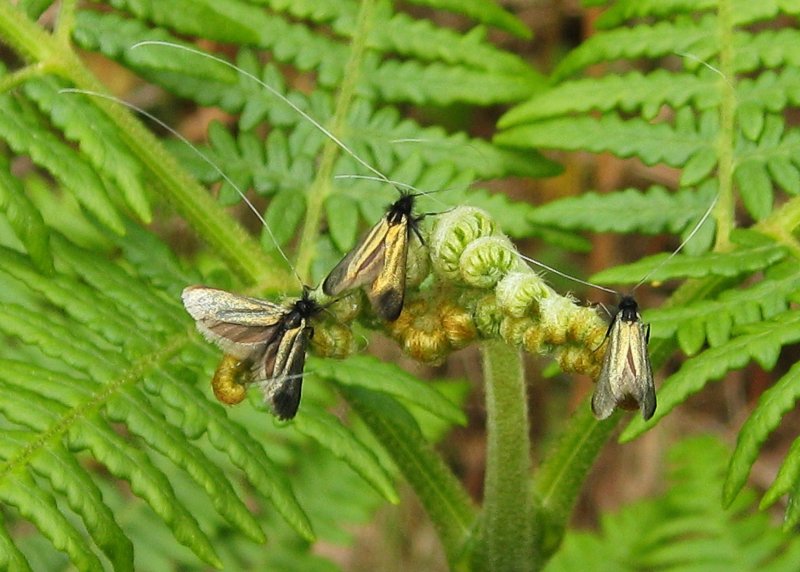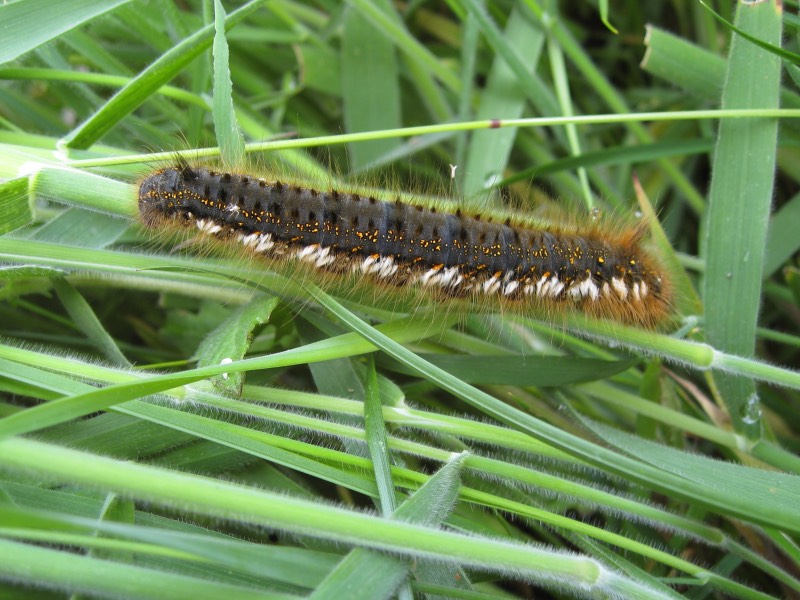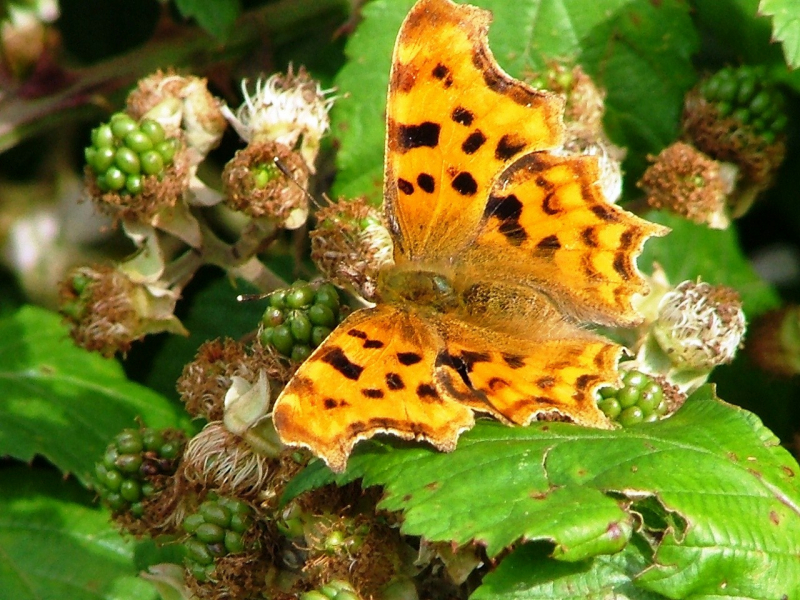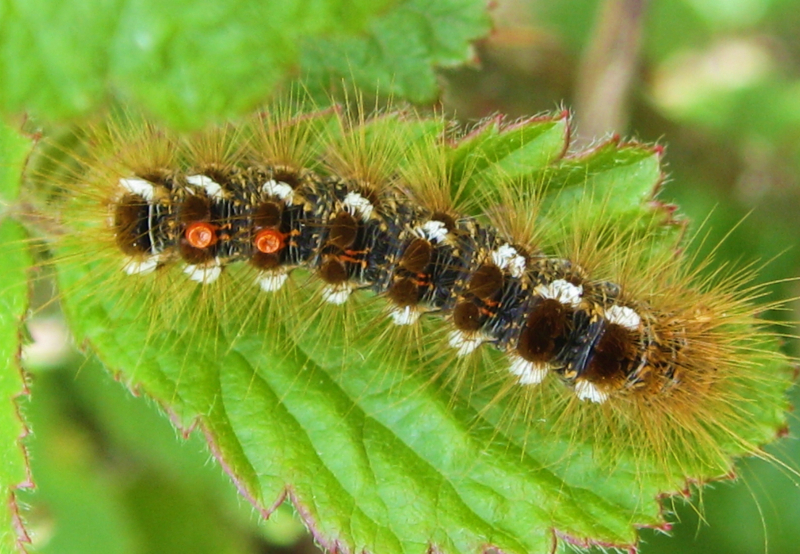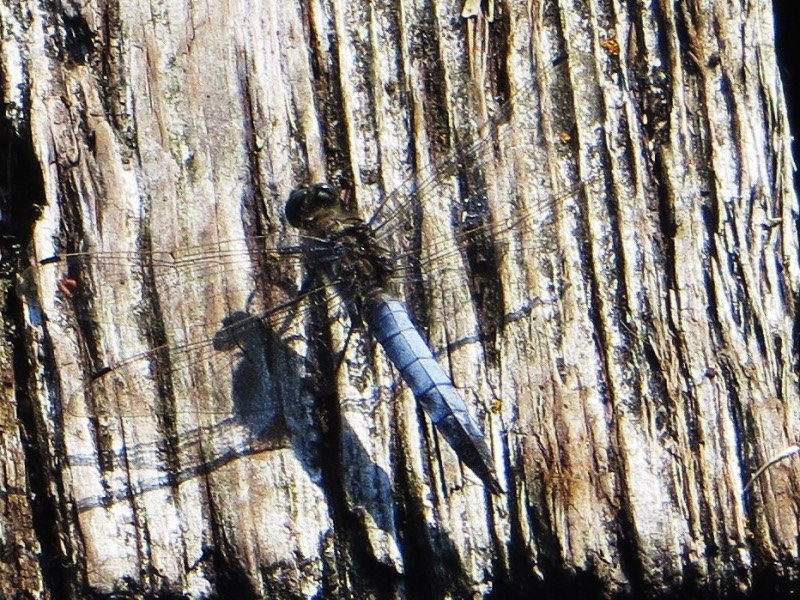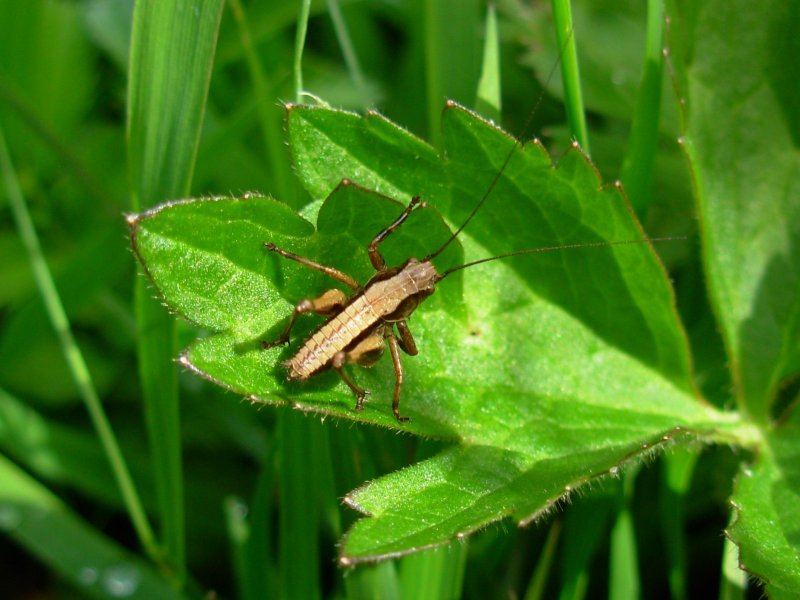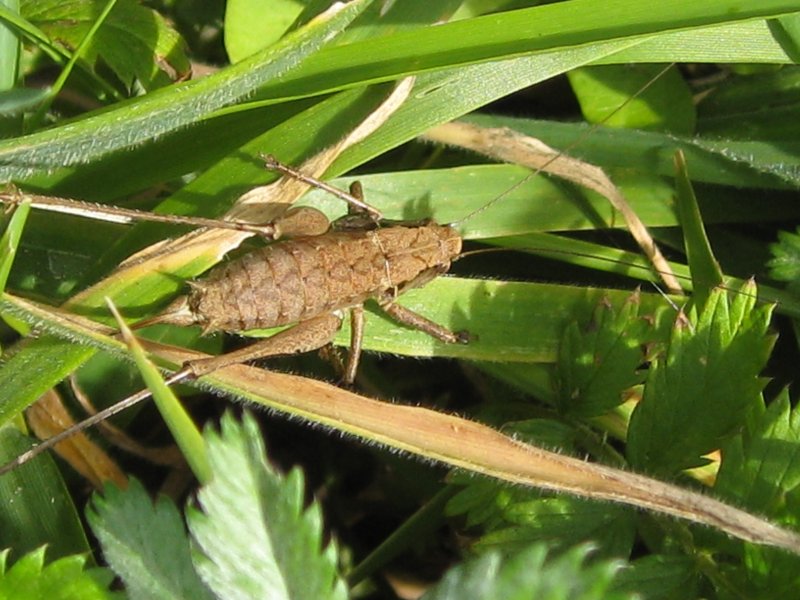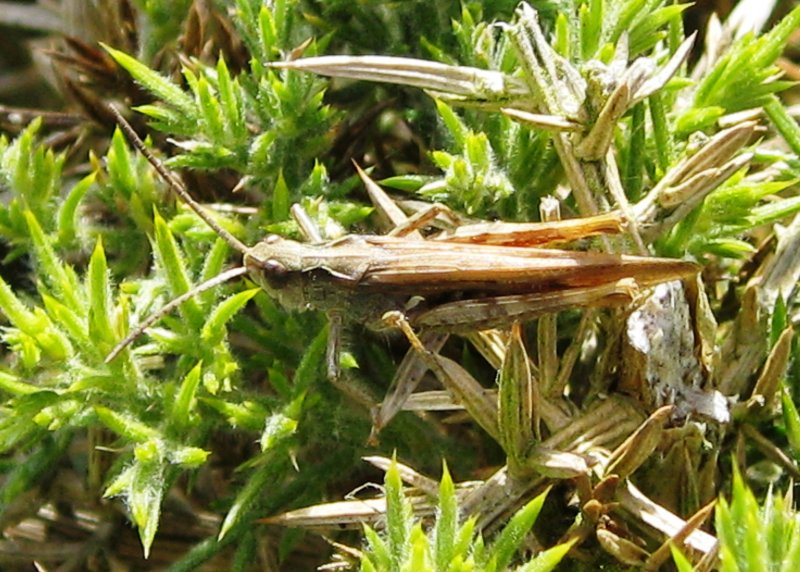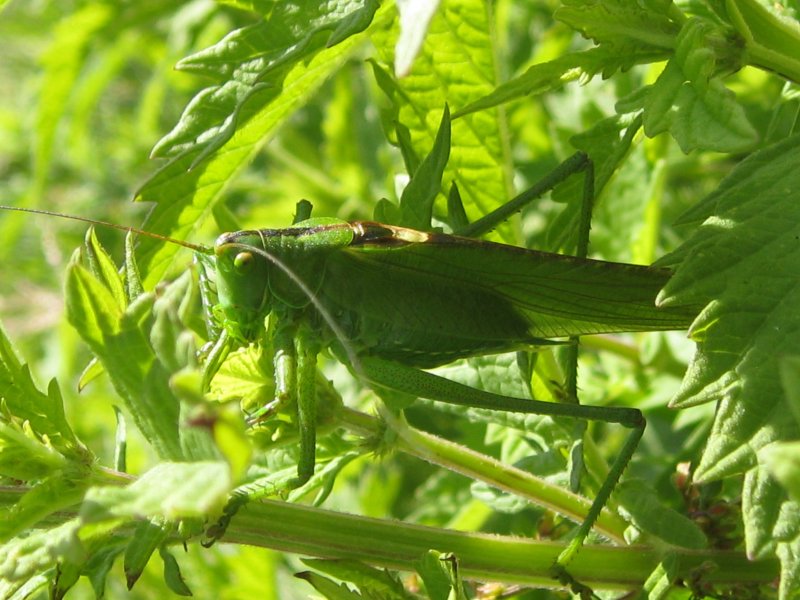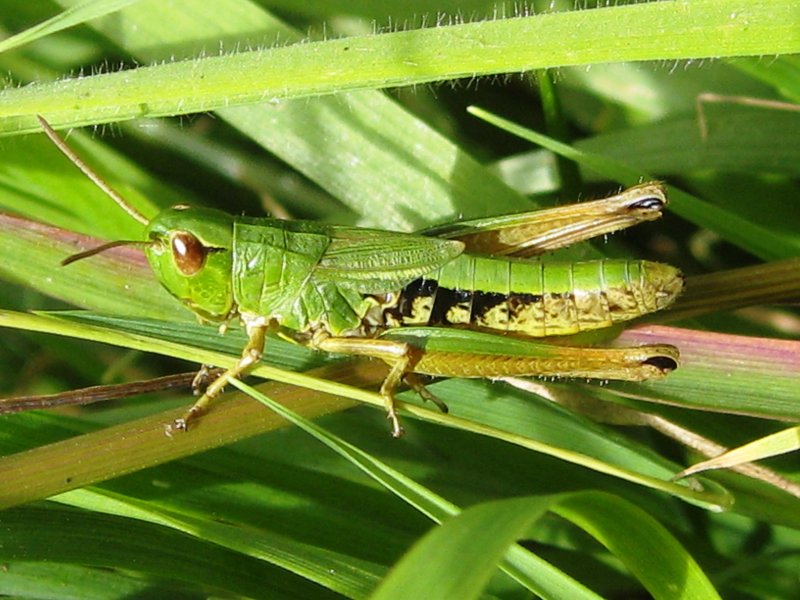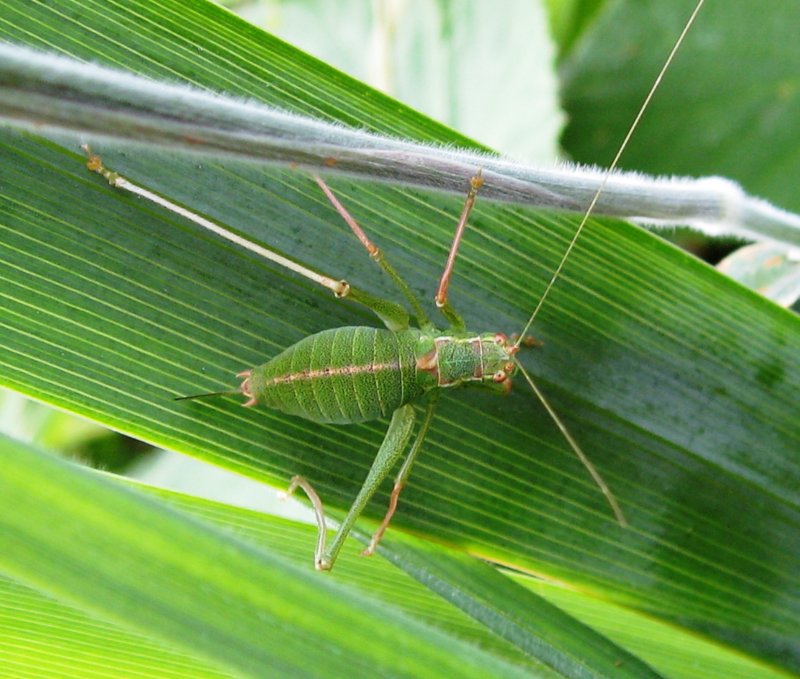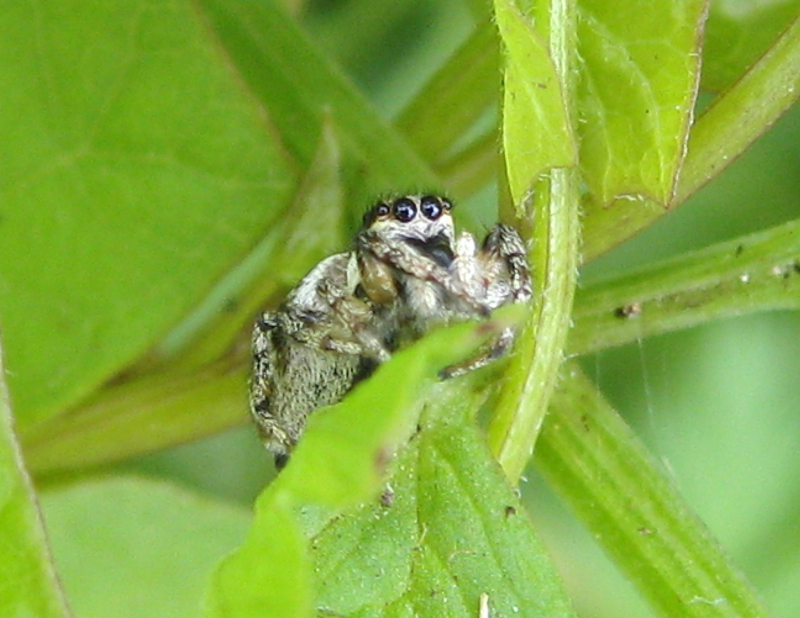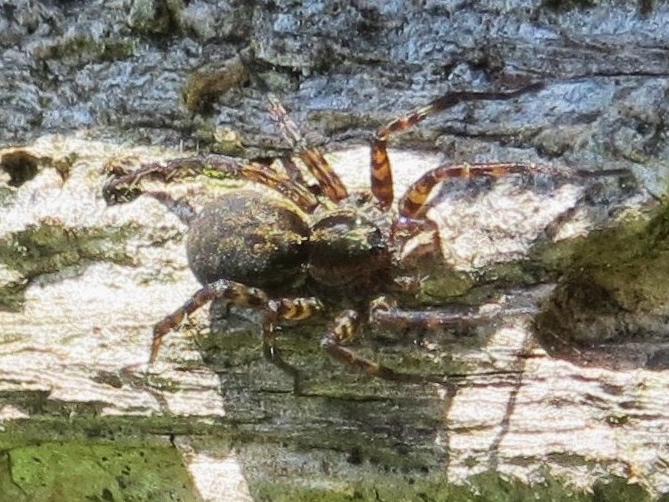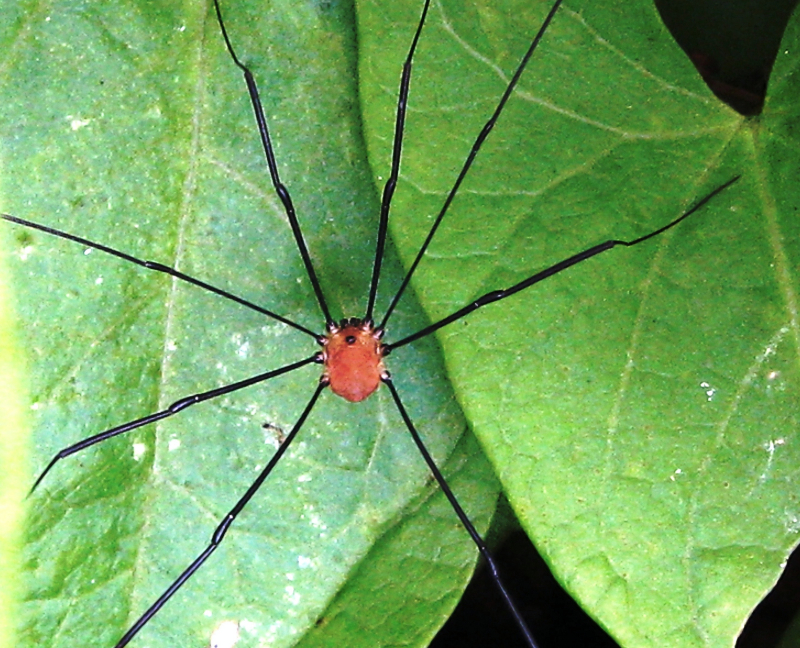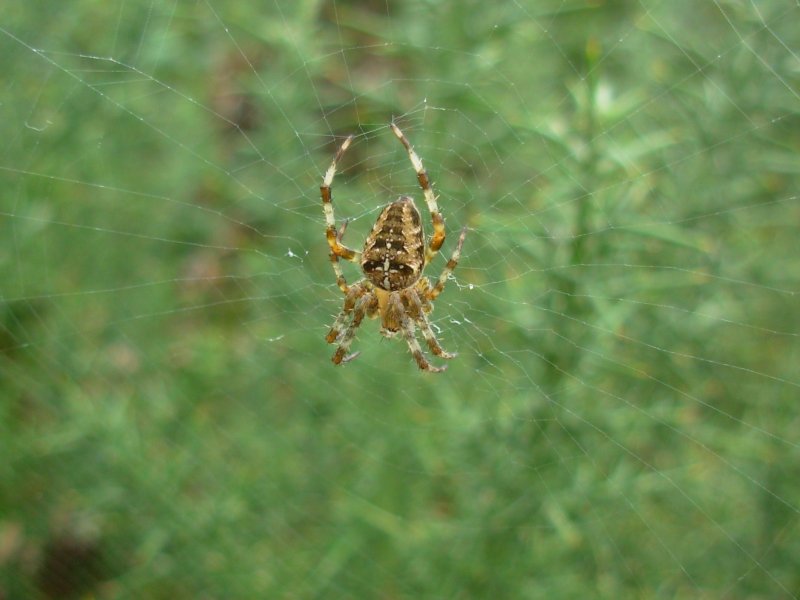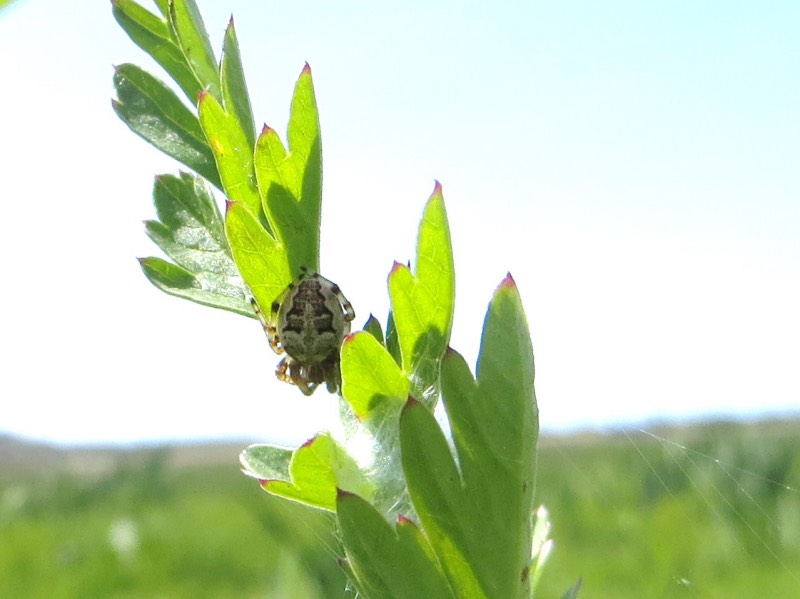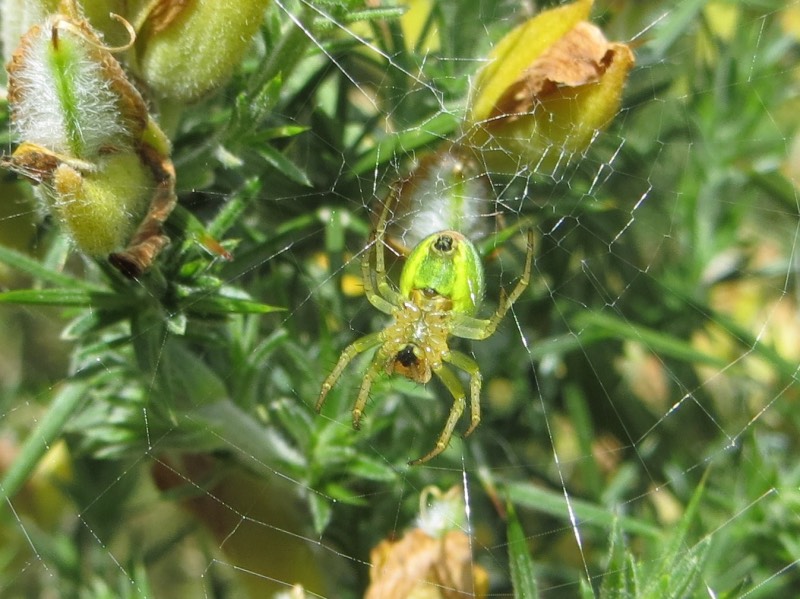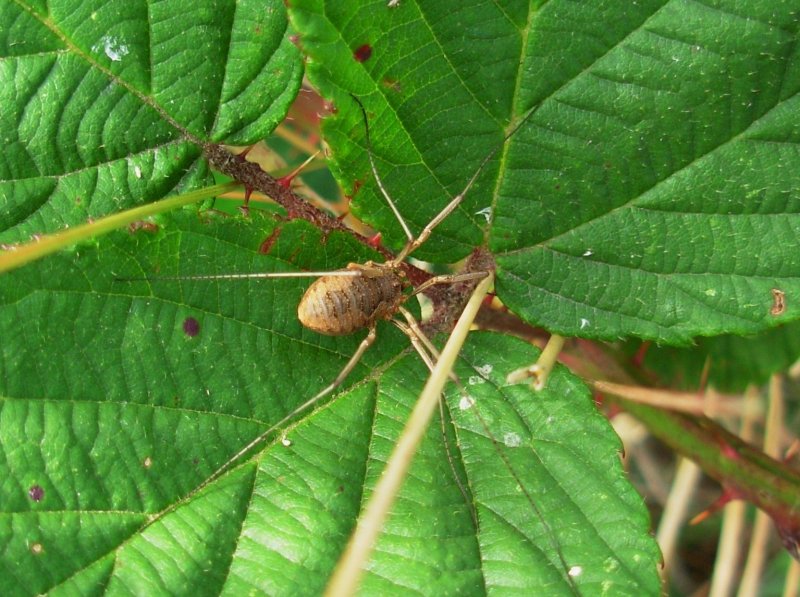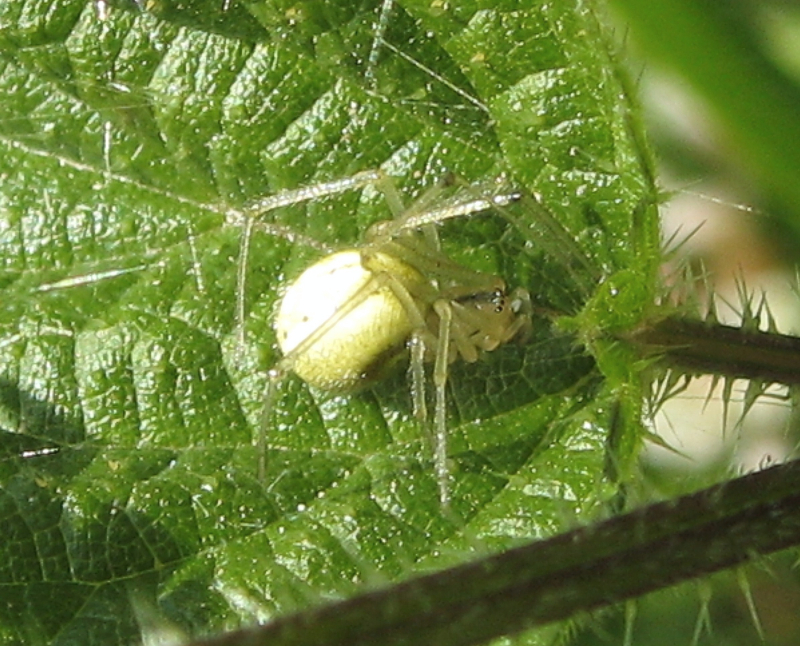Insects and Spiders
Stanpit Marsh hosts such a variety of insects and spiders that we have had to split them into several sections. Click on the images below to see larger copies of the photos and additional information on the insect or spider in question.
Bees, Beetles, Bugs and Flies
Buff-Tailed Bumble Bee
They nest deep in the ground, sometimes as deep as 1 metre. They also sometimes take over empty mouse or mole holes. The nest is lined with dry grass and moss.
Cardinal Beetle
Adults are active from May to July and feed on other insects. Larvae live under loose tree bark, and prey on small creatures living there.
Click Beetle
This species is very common and widespread throughout the UK.
Click beetles (also known as Skipjacks) have a special technique to escape from danger. They have a hinge on their thorax, and by arching their body they create a tension on the hinge, like a coiled spring. The tension can be suddenly released, catapulting the beetle into the air at a speed of more than 2 metres per second. They make a click sound when this happens. They don’t always land on their feet so might have to repeat the process several times until they do.
Common Carder Bee
Recognised by its thin coat and rather scruffy appearance. A common, sociable bee, living in colonies. It nests underground or in grassy tufts. New queens are produced in late summer/autumn and out of the whole colony only these bees survive the winter – forming a new colony in the spring.
Common Green Shieldbug
Found in North Scrubs and other shrubby areas, the Common Green Shieldbug turns reddish before hibernation in the winter, but re-emerges bright green in spring.
Dock Bug
All shieldbugs have several skin-changes – known as Instars – before becoming adults.
Dock Leaf Beetle
As the name suggests, adults feed on Dock or Green Sorrel while the larvae feed exclusively on Dock. Adults are active between May and August, typically in waterside habitats.
Eyed Ladybird
Black spots usually ringed in pale orange create an eyed appearance. Usually found near conifers.
False Oil Beetle
Up to 10mm in size, adults are most likely to be spotted in North Scrubs and other shrubby areas between April and August.
Gorse Seed Weevil
No more than 2-3mm in size, the snout is half the length of its body. These weevils were exported to New Zealand during 1931 and 1946, also to Canada, as a means of controlling gorse (which they eat.)
Gorse Shieldbug
Adult emerges from hibernation bright green, then changes colour during the summer
Hairy Shieldbug
Adults over-winter, lay eggs in Spring, and larvae fully adult by August.
Harlequin Ladybird
This voracious invasive species arrived in the UK in 2004 and is larger than native species. Colour varies.
Honey Bee
Ichneumon Fly
Ichneumon flies are parasitic flies.
Eggs are laid in grubs – mainly those of butterflies and moths, and this particular species actually lays its eggs in pupae too.
Iris Flea Beetle
Flea beetles are so named as they have enlarged legs for jumping away from danger.
Iris Weevil
4-5mm in length, the Iris Weevil can most often be seen in summer months in North Scrubs.
Rose Chafer
The adult beetle is strikingly attractive. Although rather cumbersome when moving about in vegetation, it is actually a fast flyer. They are particularly fond of roses, and often eat the petals.
Rove Beetle
The adult is a flightless predator, and lives in damp decaying matter near marshes and river banks. They are more active at night when they emerge to search for food.
Soldier Beetle
This is the most common Soldier beetle in the UK. They are often called ‘bloodsuckers’, but are actually quite harmless.
Spiked Shieldbug
This species over-winters as eggs, and reach adult-hood by July/August.
Note the thorn-like projections either side of the pronotum (“shoulders”!)
Thistle Tortoise Beetle
Its name derives from resembling a tortoise when it withdraws all appendages, and clamps down on a leaf to conceal itself.
Two-Coloured Leaf Beetle
Adults are active between March and October, typically in North Scrubs
Butterflies, Moths and Caterpillars
Speckled Wood Butterfly
This butterfly favours shady places with dappled sunlight
Small Tortoiseshell Caterpillar
Small Tortoiseshell Butterfly
This butterfly seems to have declined over recent years.
Small Purple and Gold Moth
Found on damp grassland, North Scrubs, on mint, dead-nettle, and marjoram.
Small Copper Butterfly
A very small butterfly (up to 25mm wingspan,) often seen feeding on Thrift or Fleabane.
Skipper Butterfly
Adults can be seen in flight in scrub areas between late June and August.
Silver Y Moth
Migrates from Europe, parts of Africa, and Asia. Can be numerous some years.
Red Admiral
Peacock Butterfly Caterpillar
Micro Moth Caterpillar
Meadow Brown Butterfly
Green Fairy Longhorn Moth
Metallic coloured wings. Males antenna very long – sometimes 3 times body length – females not so long.
Gatekeeper
Drinker Moth Caterpillar
The Drinker Moth gets its name from the caterpillar which likes to drink rain or dew droplets from the grass stems on which it feeds.
Comma Butterfly
Cinnabar Moth Caterpillar
Brown-Tail Moth Caterpillar
The hairs of this caterpillar are well known for causing irritation, if handled.
Dragonflies and Damselflies
Southern Hawker
As with the Migrant Hawker, the Southern Hawker is also most likely to be seen in flight in North Scrubs from June to October. Adults are day-flying. Most dragonflies only fly in calm, sunny weather, but this one also flies when it is dull or damp.
They have their own flight-paths, when searching for insects, and can often be seen hanging from gorse or other shrubs when at rest.
Migrant Hawker
With body length of up to 6cm, adults can be seen in flight (typically in the shelter of North Scrubs) from July to October. Although migratory (as its name suggests), it now breeds in Britain.
Some years, resident numbers are increased by swarms of migrants.
Black-Tailed Skimmer
Found at any open water with bare patches of ground where patrolling males often bask in the sun. They fly swiftly and low, skimming the water surface.
With a body length up to about 5cm, they can be seen flying between May and early August.
Crickets and Grasshoppers
All grasshoppers and crickets over-winter in egg form.
Depending on the species, nymphs and adults can be seen between June/July – October/November.
Nymphs have several moults (known as instars) before reaching adulthood. This can make identification difficult.
Crickets can be distinguished from grasshoppers by their long antenna. Measurements given are from front of head to tip of abdomen.
Cricket
Dark Bush Cricket
If you’re lucky you may see the shy adult Dark Bush Cricket (12 – 20mm) crawling through undergrowth between July and October.
Females are wingless. Males have very short wing parts.
Food – vegetation, small insects and flowers (pollen and nectar).
Field Grasshopper
Probably most common of the grasshoppers, the adult (15 to 25mm) is typically seen on dry grassland between June and October.
Food – grass and other vegetation.
Great Green Bush Cricket
The largest of British bush-crickets, adults grow to between 40 and 55 mm and are typically seen in rough vegetation from July to October.
Food – vegetation, small insects, caterpillars and also grasshoppers.
Meadow Grasshopper
The most common of grasshoppers. Both sexes have short wings.
Most grasshoppers shed their skin 4 times before reaching adulthood in late May or June.
Their eggs are laid batches of 15 or so in pods in soft soil, and hatch in early spring. The Meadow Grasshopper feeds on plants, but mainly thin grasses.
Note: Grasshoppers are extremely difficult to identify and a number of body factors have to be studied carefully.
Speckled Bush Cricket
Size 10 – 20 mm
The virtually wingless adult form is typically seen between July and September, most likely in dense vegetation, especially nettles.
Food – vegetation and small insects.
Spiders and Mites
Zebra Spider
Also known as jumping spiders. They have 4 pairs of eyes, the 2 large black ones in the front being the most distinctive and prominent.
They pounce and capture their prey – insects. Before jumping, however, they glue a silk thread to the surface they are jumping from, so that if they miss the prey they can climb back up the thread.
They are particularly noted for noticing humans, when they raise their heads in recognition.
Wolf Spider
Wolf spiders are not web builders.They are robust, agile hunters with good eyesight, hunting by day, eating 5-15 small insects a day, and hiding at night under stones etc. Most have no permanent homes, although some do make a burrow. Unlike most other spiders, they are quite gregarious and are often found in numbers.
Wasp Spider and egg sac
Although an introduced species (by accident during the 60’s) it is fairly common now all along the south coast.
It is completely harmless to humans, despite it’s wasp-like colouring.
It builds a strong orb web, with a distinct zig zag stablimentum through the centre.
It’s nest is a beautifully constructed pot-shape, and the offspring spend the winter in this pot mainly in the egg form – emerging as spiderlings in early spring.
They are ground feeders until reaching adulthood in August when their webs are visible.
Nursery Spider
This is a fairly large spider and can be seen in most habitats – including marshy areas!
It can be seen carrying an egg sac underneath its body, prior to building a web structure over vegetation as a nursery for the spiderlings.
It does not build a web to catch prey, but is a ground hunter.
Labrynth Spider
This spider is known as a ‘funnel web’ spider and spins its web in low vegetation and bushes. The web is of a large volume with a tubular retreat open at both ends.
Harvestman (Male)
Active from mid-summer to autumn and found especially in North Scrubs. Eggs are laid in crevices in the soil, and hatch out in the spring.
Harvestman (Female)
This is also one of the most common of harvestmen, and like the Phalangium opilio, feeds on invertebrates, dead or alive. These include caterpillars, mites, woodlice and slugs. Harvestmen also drink a lot of water, esp. dew.
Garden Spider
These vary in colour from pale yellowy-brown to very dark brown. All have a white cross-shaped group of spots on the abdomen.
They are seen from May to November on bushes and vegetation.
Furrow Orb-Weaver Spider
They hide during the day in a silken retreat constructed in the seed-heads of plants. Their web is built nearby between grasses or in low shrubbery, and is remade in the evening.
Cucumber Spider
This species of spider is often referred to as the cucumber spider, because of its colouring, and adults seen in the Spring have a noticeable red mark at the tip of the abdomen (pictured).
They prey on insects caught in an orb-web which in constructed between leaves and flowers.
Crab Spider
A member of the Thomisidae family, the Crab spider is common in Southern England and Wales. It resembles a crab and is able to scuttle sideways or backwards. It is not a web-builder, but sits on a flower with its two front legs stretched out to the side waiting to grab passing insects such as flies, grasshoppers, butterflies, moths and bees.
Common Harvestman
This is the most widespread species of Harvestman in the world.
Its habitat is meadows, bogs, forests, fields, gardens, hedgerows and walls.
It is mainly carnivorous and can catch small insects with its long legs.
Comb-Footed Spider
The colouring of this spider varies greatly, and the female (pictured) can also have a red stripe round the abdomen.



